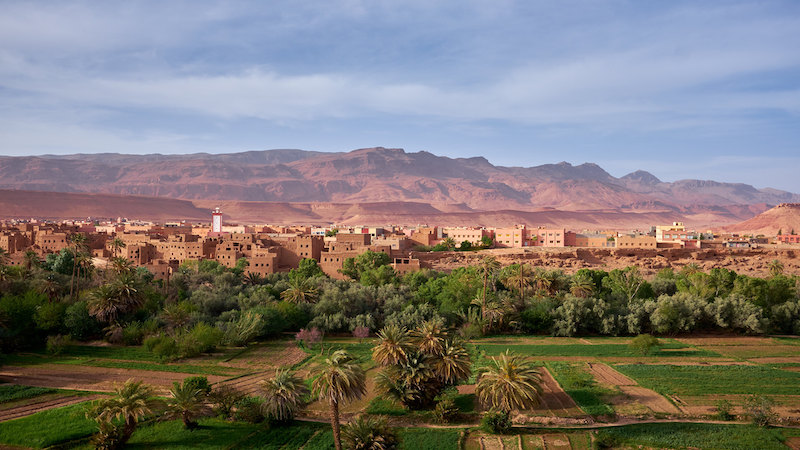For tourists, a trip to Morocco’s southeast most likely involves taking a coach bus or rented SUV to the Merzouga Desert.
The journey is equal parts dramatic and harrowing—with canyon-like views of the Atlas Mountains via treacherous switchbacks, and a vast landscape of desert beyond Ouarzazate.
Along the way—some 330 kilometers from Marrakech—the commune of Imider sits nestled on Morocco’s National Route 10 (N10). Hardly registering to passing tourists, Imider is one of the poorest and most-water stressed communities in Morocco. The climate is semi-arid—it rains only a few times a year—and poverty levels are nearly triple the national average.
Indigenous adaptation
Despite general disregard from passersby and neglect from Morocco’s central government in the northwest, Imider’s residents are proud members of the indigenous Amazigh Ait-Atta tribal confederation (otherwise known as “Berber” to western audiences).
Senegal shows African countries are not passive beneficiaries of climate finance
For centuries, Amazigh communities have populated much of the country’s southeast, adapting to the harsh and semi-arid climate that comes with being east of the mountains and isolated from the seaside. Despite the unforgiving landscape, these groups are agropastoral—herding sheep and goats and farming a variety of crops like olives, almonds dates, and vegetables. In Imider, most people live on less than a dollar a day.
In a region where annual precipitation can range from a few inches to less than an inch, water is life—or “aman iman,” as residents say.
To adapt to such low rainfall levels, Amazigh groups have long depended on a traditional system of water storage and distribution, known as ‘khettara’. This system relies on a series of underground canals to source water for farming fields and is incredibly efficient in arid and semi-arid climates. To the Amazigh, the khettara is sacred.
But as higher temperatures and drought conditions become the norm in Morocco, and as privatized companies continue to mine the south and southeast for phosphate and silver—as has been done in Imider—the centuries-old irrigation system is under threat.
The khettara irrigation
Among those affected is Mohammed Boumnir, a farmer in Imider who maintains his family’s plot of land, and harvests olives, dates, figs, grass, buckthorn, pomegranates, and radishes. The hand-dug canals of the khettara separate each set of crops like a lattice, but today they are bone dry. “This drought, the mining, it’s all affecting the farm. It’s cut off more than 80% of our water”, he told me.
In place of the dried-out khettara system, Boumnir has had to install irrigation pipes to help source water. Other farmers on adjacent plots have installed solar panels and mechanized wells to pump water from deeper beneath the ground. Those are costly endeavors that not all farmers in the area can afford.
- Bone-dry canals have forced farmers to switch to costly new irrigation methods. Photos: Rachel Santarsiero
Even with these advancements, the results of these new technologies are mixed. “The figs, almonds, olives—they’re all getting smaller, and they taste different than they used to”, Boumnir said.
With the onslaught of climate change, the Kingdom of Morocco has sought to position itself as a leader in the green technology economy—both within Africa and on the world stage with its western partners.
Mining dependence
Despite its sustainable agenda, phosphate and silver mining contributes to over 10% of the country’s GDP – just behind agriculture and tourism. But Morocco’s dependence on mining gets overshadowed by its flashy renewable energy projects, most notably the Noor Solar Power Station in Ouarzazate.
Latin America leads resistance to global shipping emission tax
Extractive capitalist projects in the southeast, like the Noor Solar Plant, or the deleterious silver mining in Imider, only exacerbate the harsh conditions that vulnerable Amazigh communities are struggling with. And while the Kingdom of Morocco continues to uphold its “green” façade to the international community, Amazigh locals in the southeast—battling land grabs, groundwater depletion, and resource extraction—are being left behind.
Hope for the future is hard to come by in Imider. Many locals are unemployed, and others are moving away. But there is one phrase that’s continually shared amongst residents, in native Tamazight: “You can pluck all the flowers, but you can’t stop the march of spring.”
Rachel Santarsiero is a climate researcher at the National Security Archive in Washington, D.C. The views expressed in this article are the author’s own.



